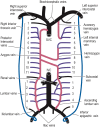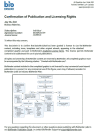Superior Vena Cava Syndrome: An Umbrella Review
- PMID: 37605686
- PMCID: PMC10439982
- DOI: 10.7759/cureus.42227
Superior Vena Cava Syndrome: An Umbrella Review
Abstract
Superior vena cava syndrome (SVCS) is a medical emergency that encompasses an array of signs and symptoms due to obstruction of blood flow through the superior vena cava (SVC). It poses a significant healthcare burden due to its associated morbidity and mortality. Its impact on the healthcare system continues to grow due to the increasing incidence of the condition. This incidence trend has been attributed to the growing use of catheters, pacemakers, and defibrillators, although it is a rare complication of these devices. The most common cause of SVCS remains malignancies accounting for up to 60% of the cases. Understanding the pathophysiology of SVCS requires understanding the anatomy, the SVC drains blood from the right and left brachiocephalic veins, which drain the head and the upper extremities accounting for about one-third of the venous blood to the heart. The most common presenting symptoms of SVCS are swelling of the face and hand, chest pain, respiratory symptoms (dyspnea, stridor, cough, hoarseness, and dysphagia), and neurologic manifestations (headaches, confusion, or visual/auditory disturbances). Symptoms generally worsen in a supine position. Diagnosis typically requires imaging, and SVCS can be graded based on classification schemas depending on the severity of symptoms and the location, understanding, and degree of obstruction. Over the past decades, the management modalities of SVCS have evolved to meet the increasing burden of the condition. Here, we present an umbrella review providing an overall assessment of the available information on SVCS, including the various management options, their indications, and a comparison of the advantages and disadvantages of these modalities.
Keywords: cerebral venous thrombosis (cvt); endovascular stent therapy; mediastinitis; superior vena cava (svc); superior vena cava syndrome.
Copyright © 2023, Shah et al.
Conflict of interest statement
The authors have declared that no competing interests exist.
Figures



References
-
- Superior vena cava syndrome. Azizi AH, Shafi I, Shah N, Rosenfield K, Schainfeld R, Sista A, Bashir R. JACC Cardiovasc Interv. 2020;13:2896–2910. - PubMed
-
- The superior vena cava syndrome. Schechter MM. https://pubmed.ncbi.nlm.nih.gov/13114214/ Am J Med Sci. 1954;227:46–56. - PubMed
-
- Superior vena cava syndrome. Klein-Weigel PF, Elitok S, Ruttloff A, et al. Vasa. 2020;49:437–448. - PubMed
-
- Superior vena cava syndrome: an increasingly frequent complication of cardiac procedures. Chee CE, Bjarnason H, Prasad A. Nat Clin Pract Cardiovasc Med. 2007;4:226–230. - PubMed
-
- The superior vena cava syndrome: clinical characteristics and evolving etiology. Rice TW, Rodriguez RM, Light RW. Medicine (Baltimore) 2006;85:37–42. - PubMed
Publication types
LinkOut - more resources
Full Text Sources
Miscellaneous
